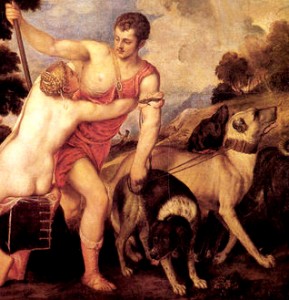Hounds and Maids: Classical and Courtly Asides in the Libretto of Venus and Adonis
The following article is adapted from the introduction to The Purcell Society’s edition of John Blow’s Venus and Adonis and is used with permission.
 The librettist of Venus and Adonis has very recently been identified by James Winn as Anne Kingsmill, subsequently married as Anne Finch, who in the early 1680s was one of the Maids of Honour to Maria Beatrice of Modena, Duchess of York. It was evidently at the behest of the Duchess – a music-lover, and one whose sophisticated taste ran to opera in particular – that the production of Calisto, the only other full-scale court masque in the reign of Charles II, had taken place in 1675.
The librettist of Venus and Adonis has very recently been identified by James Winn as Anne Kingsmill, subsequently married as Anne Finch, who in the early 1680s was one of the Maids of Honour to Maria Beatrice of Modena, Duchess of York. It was evidently at the behest of the Duchess – a music-lover, and one whose sophisticated taste ran to opera in particular – that the production of Calisto, the only other full-scale court masque in the reign of Charles II, had taken place in 1675.
Like that work, as Professor Winn observes, Venus and Adonis adopts a classical myth, features pastoral lovers, and focuses on female characters (Calisto, indeed, had an all-female cast – including Mary Davies, in her only return to the boards after her retirement save for her subsequent appearance in Venus and Adonis). He further notes that much of the second act of Venus and Adonis, which is unconnected with the myth, instead directly portrays the duties and interests of the Maids of Honour (represented in the masque by the Graces).
Throughout much of the libretto the mythical central plot-line is intertwined with other references to aspects of court life. The classical sources, with which Kingsmill was evidently very well acquainted, are treated with considerable freedom – the most obvious liberty taken with the traditional narrative being the reversal, in Act I, of Adonis’s eagerness to go hunting and Venus’s reluctance to accede to it. (An attempt has been made to read political allegory into this reversal, but it is far more likely that the intention was simply to intensify the tragic climax, by laying the responsibility for Venus’s bereavement at her own door.) Venus’s instruction of Cupid in the arts of perverse marksmanship, in Act II, has no specific basis in myth, though the notion that he should “make some love they know not why” is firmly established in Western tradition, as is Cupid’s advice to Venus that the best guarantee of a lover’s fidelity is to “use him very ill”. And Adonis’s hounds in Act I are, curiously, among the roll-call of those of a different huntsman, Actæon, given in Ovid’s Metamorphoses, III:
dum dubitat, uidere canes primique Melampus
Ichnobatesque sagax latratu signa dedere,
Cnosius Ichnobates, Spartana gente Melampus.
(While he [Actæon, now transformed into a stag] was hesitating, he was seen by his dogs;
Melampus and keen Ichnobates were the first to give the signal with their bark,
Ichnobates was a Cnossian and Melampus of Spartan breed.)
et substricta gerens Sicyonius ilia Ladon …
(and Sicyonian Ladon with the hollow flanks …)
… hirsutaque corpore Lachne …
(… and shaggy Lachne …)
Ovid records the names of 36 of the 50 hounds, and it appears that Kingsmill, perhaps over-relying on memory when drawing on a classical source she knew well, confused Ladon – who is described in the libretto as “strong and bold” – with another of his fellows:
praeualidusque Lacon …
(and Lacon, who was outstandingly strong …)
A literal translation of the two names tends to confirm this, for Ladon means Catcher, while Lacon means Spartan. (As for the names of the other dogs, Melampus translates as Black-foot and Lachne as Shag.)
With the exception of the Graces’ scene all the contemporary references in the libretto are gently satirical in tone. Two of them, Cupid’s little homily on fidelity in the Prologue and parts of the dialogue between Cupid and Venus in Act II, deal with the mores and especially the sexual morals of the court. One satirical sally in the libretto has a different and unexpected target – the composer, who joined in the joke with obvious relish. It was Blow who, as Master of the Children of the Chapel Royal, was responsible for teaching his young charges to read and write: the Cupids’ Lesson in Act II gives us an amusing glimpse of his methods, and through his own eyes at that!